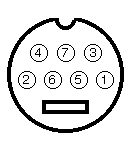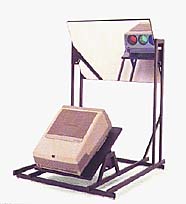Stereo 3-D video on the Grid?
Academic Computing Services
University of Kansas
The Internet2 yearly meeting in Atlanta in October 2000 included a
demonstration of 3-D video streaming over Internet2:
Network-Based Real-Time Full-Motion Stereo Imaging for Teaching and
Research.
The demo came out of
John
MacKenzie's Microbiology lab at North Carolina State University.
Here's how it worked:
- dual cameras arranged with their lense openings approximately
6cm apart fed video capture hardware and software that created....
- separate video streams carrying the data from each camera across
the network to...
- another system whose video software decoded the
video streams and sent them to...
- separate projectors which projected each video stream through
polarizing filters onto the...
- SAME movie screen (to create a single overlayed, but slightly
offset, image) where it was observed through...
- polarized paper glasses.
Note that the two projectors were arranged one above the other
on separate levels of a specially constructed stand that allowed for
fine adjustments in each dimension. Here is a similar projector stand:

Chief twin projector stand: (503-649-6055)
We have put together a version of this approach to run over the usual AG
infrastructure using:
- dual iREZ CritterSV cameras (available for about $150
online, which produce S-video signals
(hence the "SV") to be fed to our Access Grid
Hauppauge WinTV Model 401 video
capture cards.

Note that the cable to the CritterCamSV is a mini-DIN-7:

whereas the "usual S-video cable connector" is a mini-DIN-4. Since
the CritterCamSV cable is only about 4 feet long it is usually
necessary to use an extension cord with each camera. mini-DIN-7
extension cords are extremely difficult to come by, but
Black Box is able to construct
such cords on a custom contract basis.
- sheets of linearly polarized plastic discs from Edumund's Scientifics
(at approximately $22.50 per pair), and
- plain white linearly polarized 3-D paper glasses from
American
Paper Optics (at approximately $27.50 for 50 pair--minimum order), and
- a 70x70" Da-lite Picture King
(at approximately $300 from
Presenting Solutions), constructed from "Super Wonderlite
silver lenticular material".
Some screen materials will NOT maintain polarization of 3-D images.
Matte white, beaded white, etc. will depolarize the projected image,
and will show a double image instead of a 3-D image.
Silver surfaced or aluminized screens are commonly used to
preserve polarization.
Related links
- Pixera
- Another vendor of small cameras.
- Stereoscopy.com
- Claims to be " your one stop information source about the
fascinating world of 3D."
- Reel 3D
- Claims to be the "Worlds Largest Mail Order Selection of New 3-D
Supplies," and has several options for glasses (including
paper, plastic framed, clip-ons, and flip-up clip-ons).
- What is polarized
light?
- A short description of polarization. Linear polarization is
usually used at 45 and 135 degrees, which has apparently been
a standard since the early 1940's.
- Various issues
- A list of discussion list contributions on various 3D issues (such
as screens, 3D electron microscopy, etc.)
compiled by the Electron Microscope Core Lab at the U. of Florida.
-
The Solar System in 3D
- 3-D images of geological formations throughout the solar system
from the Lunar and Planetary Institute
-
3-D Displays: A review of current technologies by the
Heinrich Herz Institute
- Excerpt: Optimum results have been reported for aluminized surfaces
and for translucent opalised acrylic screens.
- New generation of desktop computer
interfaces published by the Heinrich Herz Institute
- Are you ready for your 3-D desktop?
-
Stereophotography: An introduction to stereo photo technology
and practical suggestions for stereo photography
- Pretty much covers the gamut
-
Da-lite mirror stand
- For back-projection in a cramped environment, you may want to
use a mirror to increase your throw distance, as is done with
this mirror stand:

- Using
mirrors
- Silver mirrors are ok, but at angles of incidence close to
45 degrees aluminum mirrors will eliminate polarization except under
ideal conditions.
- The
3-D Internet--Will it take off?
- The way of the future? The mainstream browser? They say so in 96.
- Must see
3-D engines
- Driving this equipment with software rather than video streams.
Questions
- how to point and focus cameras for 3-D video,
- how to point and focus the projectors (image size, image
register, keystone effects, etc.),
- how to build or buy suitable projector stands, screens, filters, etc.,
- how to arrange the polarizing filters,
- whether (or how well) we can expect this to work with the commodity
products, AG software, and network connectivity we have,
- how to record such streams...can Voyager be used?
- how does 3-D affect the video conference experience (sense of
presence, level of intimacy, etc.)
There is an online version of this presentation located at:
http://people.cc.ku.edu/~grobe/3D-for-ANL.html.
Author's e-mail is
grobe@ku.edu
.




